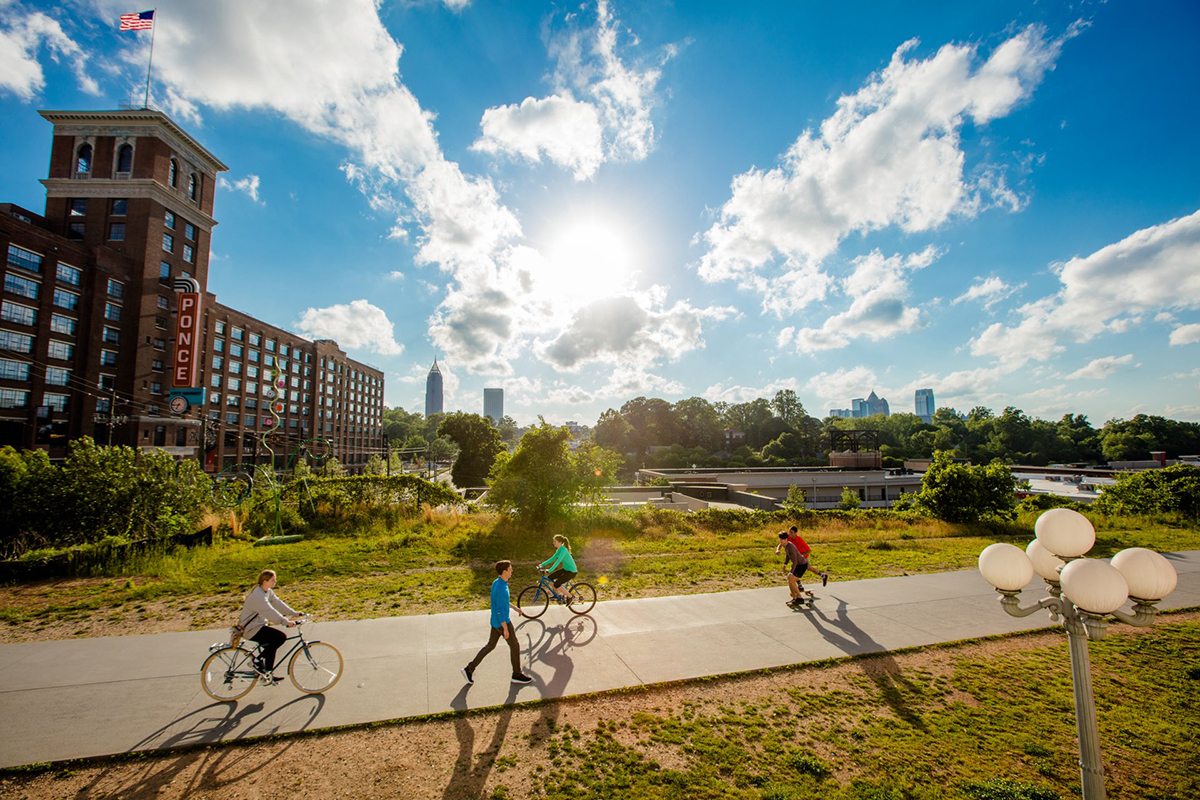
Photograph by Ralph Daniel
It’s impossible to say exactly when Atlanta changed, because Atlanta has always been changing. I only know firsthand about the Atlanta of the past 30 years, the one that arrived on the heels of white-flight Atlanta and well after Civil Rights Atlanta. But that’s enough time to figure out that Atlanta is a place more able than most to be shaped and reshaped. It’s enough time to know that to be an Atlantan is to be at peace with its constant mutation.
For as long as I’ve known this place (and certainly longer), Atlanta has been a city with room to grow—in terms of population, but also in ways less tangible. Its identity. Its myth. In the ’90s, the city cemented its place as the capital of the “New South,” sure, but it was unclear whether Atlanta would ever be terribly relevant beyond its region—and even whether it would amount to anything more than the stagnant core to its (mostly) thriving suburbs.
The answer is obvious now. At some point in the past decade, maybe two—somewhere between OutKast’s “Hey, Ya!” and Migos’s “Versace”, the BeltLine’s first Lantern Parade and Atlanta United’s first MLS Cup—the city finally, indisputably became cool. People who’ve never lived here say “Atlanta” differently now, with respect. They’ve softened those T’s after listening to rappers burnish the city’s unsavory secrets. They’ve been tipped off to Atlanta’s complexities after watching Donald Glover’s brilliant TV show. Up until a decade ago, Atlanta was hesitant to accept all the facets of itself. There was a time when rappers got little media attention unless they landed in jail. Now, they make news for serving on the mayor’s transition team. Their music has become the city’s most significant cultural export. It’s what took Atlanta mainstream.
It’s not just hip-hop. The arrival of Hollywood increased our cultural cachet. (In recent years, more feature films were shot in Georgia than California. All of a sudden, there are studios and sound stages. Celebrity sightings have become ubiquitous.) And the urban core has bona fide communal space, thanks to the BeltLine and the neighborhoods it has transformed. Atlanta might not be walkable yet, but the BeltLine finally gives us reason to abandon our cars (temporarily, anyway) and meet each other shoulder-to-shoulder. Increasingly, people are flocking here from other, bigger cities. And more people who grew up here are deciding to stay.
However, in this majority-black city—one that has earned its prominence thanks in large part to the contributions of black Atlantans—it is still white Atlantans who are benefiting most.
Since 2000, Atlanta’s urban-core neighborhoods have increasingly lost their lowest-income, often black residents and gained higher-income, predominantly white ones. As of 2016, one in five Atlantans lived in one of those gentrifying neighborhoods. (Only D.C. had a higher percentage of people living in such neighborhoods; Atlanta’s percentage exceeded even that of fast-gentrifying L.A.) In those neighborhoods, 6,500 low-income and 8,400 black Atlantans were replaced, incredibly, by 25,900 white Atlantans between 2000 and 2016. If the demographic trends continue (and they’re showing no sign of abating), Atlanta—a city that was 67 percent black in 1990 and 54 percent black in 2010—will no longer be majority-black well before 2030.
The city’s home values hit a record high last year; an average single-family home in Inman Park surpassed $720,000. And Atlanta maintains the most extreme income disparity in the country. Nowhere is the gap between the highest-earning 20 percent and the lowest-earning 20 percent so vast.
As the character Paper Boi deadpans in Atlanta’s Robbin’ Season, in which Glover crafts the best modern-day depiction of this messy, conflicted, inspiring place: “Welcome to Atlanta, man. All you need is some money.”
A lot of money.
I didn’t know what to expect when I moved from the Northeast to Atlanta (er, Cobb County) as a preteen, but my parents did: great schools, better job opportunities, and the potential to buy a house—which they did, for $100,000 in 1990. We were part of the wave of newcomers that crested in the ’90s, when the 10 counties that make up the metro area gained a whopping 870,000 people, more than in any decade before or after. Yet during that decade, the population of the city that’s the nucleus of this region remained flat.
In the 1990s, everyone thought the Olympics would be the big event that would change the course of Atlanta’s history and make it a world-class city. I’d argue that its trajectory was more significantly altered by something that happened not in 1996 but three years earlier. That’s when 43,000 high school students became the first recipients of Georgia’s new HOPE scholarship. I graduated from high school the following year, in 1994, and decided it made no sense to attend college out of state when I could get an education here for free. Back then, there were still income restrictions on HOPE. The year I qualified, it was awarded only to students who came from households earning less than $100,000 annually (up from $66,000 the year before). The income cap was lifted the following year, which watered down the point of HOPE, changing it from a program that favored the academically gifted who weren’t financially privileged to one that favored the academically gifted, period—and wound up underserving the underprivileged.
By 2011, six times as many students received the scholarship as in its inaugural year. Each year for a quarter-century now, tens of thousands of high school graduates—disproportionately white and mid- to high-income ones, it turns out—who might have left Georgia stayed instead. And in staying, many of them, including me, came to see Atlanta not as a second-rate city but as a place to put down roots.
In an attempt to create more options for prospective Atlanta residents such as those, the Atlanta Housing Authority launched another initiative in the ’90s that aimed to create more dynamic and livable neighborhoods. Coincidentally, it was called HOPE VI. The federal program, which Atlanta piloted, helped cities reinvent their urban cores by tearing down traditional public-housing complexes and replacing them with “mixed-income” communities. Atlanta was HOPE VI’s ideal guinea pig. In 1936, the city had been the site of the country’s first public-housing complex, Techwood Homes, just south of Georgia Tech. Sixty years later, Atlanta had a higher percentage of residents living in public housing than any other city. Who better to pioneer the brave new world of subsidized housing? The timing was fortuitous, since the deteriorated state of Techwood would be an undeniable eyesore when the world’s attention would be fixed on the city for the ’96 Games. Atlanta wanted to show its best face.
The city got its first HOPE VI federal grant in 1993, the same year the first HOPE scholarships were handed out, and the demolition of the projects began soon after. By 2011, the year that the scholarship was awarded to a record 260,000 students, Atlanta had torn down the last of its 14,000 public housing units. Along the way, the housing authority used HOPE VI not just to replace the projects with safer, prettier communities boasting pools and shops but to serve as an economic catalyst that would kickstart the “revitalization” of nearby neighborhoods: Kirkwood, East Lake, the Westside, and the Memorial Drive corridor near Grant Park.
The irony of HOPE VI is that it benefited the many people who moved to the newly developed areas surrounding the demolished projects but benefited far fewer of the people who had lived in those projects—or who would need affordable housing in the future. Fewer than 20 percent of former residents returned to the new mixed-income communities. The others used vouchers to find housing—and the vast majority of them wound up in the highest-poverty pockets of the city. And without any true public housing left in Atlanta, the waitlist for vouchers—the only affordable-housing resource left—skyrocketed.
The irony of the HOPE scholarship was that it kept more students in state and ensured that more of them went to college, but it also made Georgia universities harder to get into and failed to do nearly enough to benefit black, Hispanic, and low-income students. As early as 2000, one analysis warned that HOPE “widened the gap in college attendance between blacks and whites and between those from low- and high-income families.” The two big HOPES of the ’90s gave hope to people who already had an abundance of it.
I moved to Atlanta proper in 2000, two years after graduating from UGA’s journalism school and fresh from my job as a crime reporter for the Macon Telegraph. I was in my 20s and wanted to better understand that elusive city at the heart of my formative years. I wanted to help tell its stories.
Like my parents, I also came here for a better job opportunity than I was able to land elsewhere, and for the potential to buy a house—which I did, for $200,000 in 2003. Unlike in the ’90s, this time I instantly felt like an Atlantan. I worked as a staff writer for the scrappy alternative weekly paper, Creative Loafing, a portal to the parts of Atlanta that most intrigued me: its disappearing public housing projects, its burgeoning hip-hop scene, its changing neighborhoods where worlds were colliding, and, soon, its ambitious plan to unite those neighborhoods with an idealistic-sounding idea—the BeltLine—from a Georgia Tech grad.
As a young journalist, I dug through piles of police reports in the bowels of mammoth City Hall East. I spent days interviewing soon-to-be-displaced families who lived in Capitol Homes on Memorial Drive (the next public housing project up for demolition, to be replaced by the $200 million mixed-income Capitol Gateway), and I spent nights a block away at Lenny’s, a club fashioned out of two double-wide trailers, where I saw Deerhunter and the Black Lips before they became huge.
And then, in 2011, the year that the city’s population started to rapidly increase, I moved. I didn’t leave Atlanta so much as follow a career that was calling me to Chicago, then Los Angeles.
When I returned in 2018, driving around town—and walking down the now-packed segments of the BeltLine—was like watching a time-lapse of someone aging in reverse. Atlanta was shinier. Happier. Renewed. Reclaimed. Reinvented.
Flags for a new team—a new sport!–were flapping everywhere. MARTA was flooded with fans of that team, Atlanta United, but devoid of the fans for the team I’d grown up with, the Braves. I drove down a Victorian-lined street in Kirkwood, dismayed that the houses had fallen into grave disrepair—and then happened upon a film crew; the houses had been temporarily transformed to look decrepit, for a Halloween-set shoot. Under that false veneer, they had been meticulously renovated.
The Old Fourth Ward literally was unrecognizable. The hulking, half-abandoned City Hall East building where I used to pull police reports was now Ponce City Market, home to $20 hot dogs, $70 sweatshirts, and a billion-dollar tech company. Just south of there, the site of the old Creative Loafing offices now overlooks the BeltLine-adjacent Historic Fourth Ward Skatepark.
Down on Memorial Drive, near where the Capitol Homes public housing project had been razed, a two-bedroom apartment can go for as much as $3,000 a month. A similar development deluge had hit Inman Park and Grant Park, unsurprisingly, but also was arriving in Summerhill, West End, and Westview, historically black neighborhoods that had never seen this type of investment.
If this influx of wealth were benefiting people equally, or even sort of equally, these changes would be easier to accept. And they would be easier to accept if more had been done to preserve the affordability of these intown communities as they were transforming.
Exploring all these neighborhoods, as new to me as they were familiar, I couldn’t help but feel an equal sense of excitement and of loss. Excitement for all the options right in front in me. And loss for the opportunity these neighborhoods missed: the chance to do better for everyone.
For years, one of Atlanta’s selling points was that it was a place where you could reinvent yourself—because it was cheaper to live here than in a lot of places but still offered as many paths to success. Of course, we had poverty and crime, but in many ways, it felt like Atlanta was America writ small—a city of opportunity.
Now, Atlanta feels increasingly like those other places. And it’s possible that, in the city’s constant compulsion to reinvent itself, it lost an important part of itself instead.
This article is part of What makes us Atlantans and appears in our January 2020 issue.














